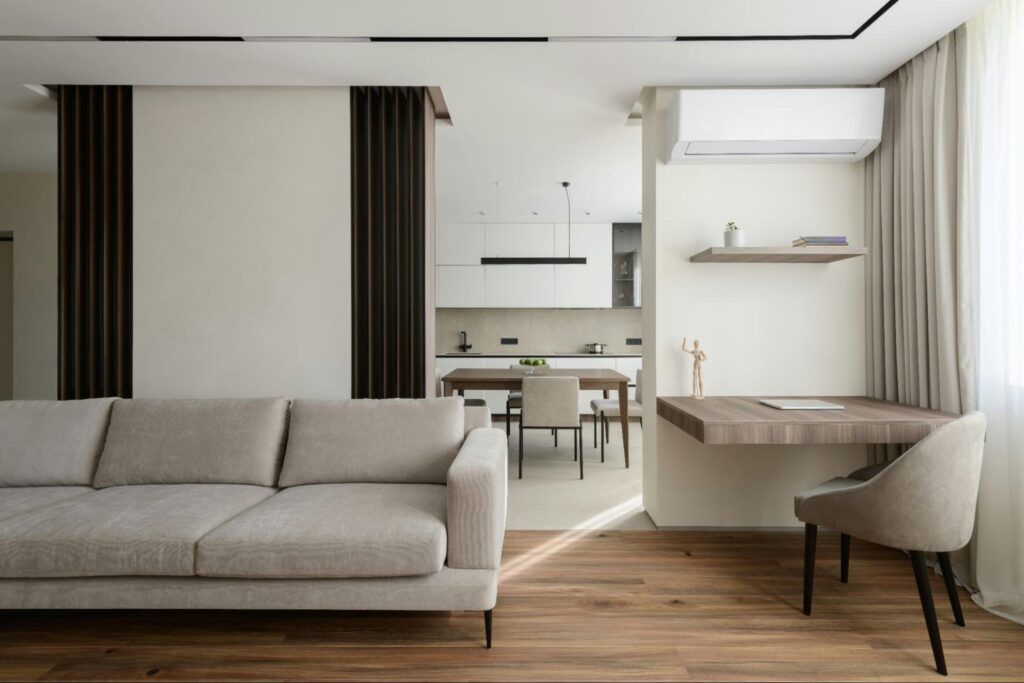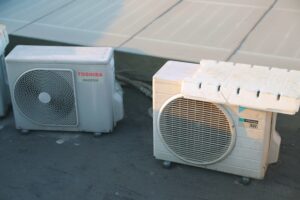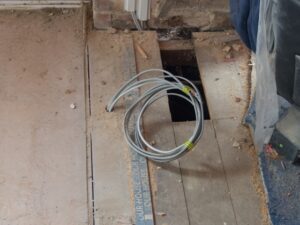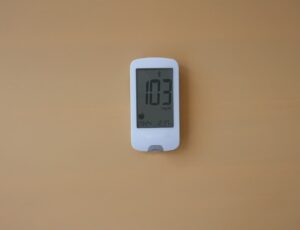Choosing energy-efficient heating and cooling options can greatly reduce your energy bills while being kinder to the environment.
Upgrading your current HVAC system to a more energy-efficient model is one of the best ways to achieve this. This simple change helps conserve energy and improves the comfort of your home or office.
Excel Mechanical is dedicated to providing top-notch HVAC and plumbing services to meet your specific needs and budget. Our team is committed to exceptional quality and great value for residential or commercial projects. With our expertise, you can be sure that you will receive the best possible system tailored to your situation.
Understanding new, efficient systems and their benefits is key to making informed decisions about heating and cooling your space. Our goal is to guide you in selecting systems that work optimally for you.
In this blog, we will explore:
- How energy-efficient heating and cooling systems can save you money
- Why upgrading your HVAC system is a smart investment for comfort and efficiency
- The benefits of choosing the right system and contractor for the job
Ready to dive into the world of energy-efficient systems?
Let’s look at the key benefits and how they’ll improve both your home and your wallet.
Fundamentals of Energy-Efficient Heating and Cooling
Understanding the basics of energy-efficient heating and cooling helps you save on utility bills and enhance comfort. Focusing on key principles ensures you choose the best systems suited for your needs.
Thermal Comfort Principles
Thermal comfort revolves around maintaining a temperature that feels just right.
It combines air temperature, humidity, and airflow to create a pleasant environment, regardless of the season.
Air movement plays a crucial role. A gentle breeze can make you feel cooler without lowering the thermostat. Insulation is equally essential. It keeps heat inside during winter and outside in summer, reducing the load on your HVAC system.
Humidity control is another aspect. Too much moisture makes it hard to feel cool, while dry air can feel chilly. Using dehumidifiers or humidifiers helps balance this.
Energy Efficiency Basics
Energy efficiency focuses on reducing energy consumption without sacrificing comfort.
Modern HVAC systems are designed to use less power, saving money and resources. Look for models with high SEER (Seasonal Energy Efficiency Ratio) ratings, as they are more efficient.
Programmable thermostats let you set temperatures based on your schedule, preventing unnecessary energy use when you’re not home. Regular maintenance also boosts efficiency.
Cleaning filters and ducts ensures everything runs smoothly.
Heating Options
Choosing the right heating option is vital for comfort and energy savings. This section explores various systems, including their benefits and how they work effectively.
Forced Air Systems
Forced air systems are popular in many homes due to their efficiency and ability to quickly heat large spaces. They use a furnace to heat air, which is then distributed through ducts and vents. These systems are versatile and can be powered by natural gas, electricity, or oil.
Regular maintenance is key to ensuring their effectiveness, as filters must be replaced periodically to improve air quality and system performance. Forced air systems can also be paired with air conditioning units, providing a complete heating and cooling solution.
Radiant Heating
Radiant heating provides warmth directly to floors or panels in the walls and ceilings.
This method is known for its even heat distribution and comfort. Unlike forced air systems, radiant heating does not circulate allergens or dust, making it a better option for those with allergies.
Installation can be more costly upfront, but the system’s energy efficiency often leads to savings in the long run. It is typically powered by water heated through a boiler, electric cables, or mats.
Radiant heating is particularly effective in smaller spaces or areas with tile or wood flooring.
Geothermal Heat Pumps
Geothermal heat pumps utilize the stable temperature beneath the Earth’s surface to heat your home. These systems are extremely efficient and environmentally friendly, using renewable energy. They can significantly reduce energy bills and have a long lifespan.
Installation requires a higher initial investment, but the heating and cooling benefits often outweigh these costs over time. Geothermal systems can be used for heating and cooling, offering a comprehensive solution for year-round comfort.
Biomass Heating
Biomass heating uses organic materials, such as wood pellets or chips, as fuel. This renewable energy source can be a sustainable alternative to traditional heating methods. It is ideal for those looking to reduce their carbon footprint while maintaining a comfortable living environment.
Biomass boilers and stoves are available in various sizes and can be used to heat specific areas or entire homes. They tend to require regular loading and maintenance, but automated feeders can reduce manual work.
Biomass heating systems are most efficient in homes with ample storage space for fuel.
Cooling Options
Choosing the right cooling system is essential for keeping your home or business comfortable while managing energy costs. Different systems offer unique benefits, which can help you make an informed decision.
Central Air Conditioning
Central air conditioning is a popular choice for cooling large spaces.
It uses a network of ducts to distribute cool air evenly throughout your home. This system relies on an outdoor unit and an indoor coil. The outdoor unit releases heat, while the indoor coil cools the air.
Central AC provides consistent and comprehensive cooling, which is ideal for large homes. One advantage is the ability to maintain a uniform temperature across all rooms. However, it requires proper ductwork installation, which can be expensive.
Regular maintenance by professionals can significantly enhance the efficiency and lifespan of your system.
Evaporative Coolers
Evaporative coolers, also known as swamp coolers, are well-suited for dry climates.
They cool the air by passing it over water-saturated pads, where it picks up moisture and loses heat. This method is highly energy-efficient and eco-friendly due to minimal electricity usage.
Swamp coolers are generally more affordable to install and operate than traditional air conditioners. They also add moisture to the air, which can benefit arid regions. However, they are less effective in humid areas.
Proper installation and maintenance by skilled technicians ensure optimal performance and longevity.
Ductless Mini-Splits
Ductless mini-splits offer a flexible cooling solution without the need for extensive ductwork.
They consist of an outdoor compressor and one or more indoor units that deliver cooled air directly into each room. Each room can have its temperature settings, enhancing comfort and efficiency.
These systems are perfect for homes where adding ductwork is impractical. They also allow for zoning, enabling you to cool specific areas as needed and save on energy costs. Installation is relatively straightforward, but should always be handled by experienced professionals to avoid system inefficiencies.
Regular upkeep is essential to maintain performance.
High-Efficiency Window Units
High-efficiency window units are compact, cost-effective cooling options for smaller spaces.
They fit into standard window frames and are perfect for apartments or individual rooms. These units now have improved technology that lowers energy consumption while maintaining cooling power.
They offer the benefit of easy installation and portability. Modern high-efficiency models often come with programmable timers and remote controls, adding convenience. While not as powerful as central systems, they provide targeted cooling where you need it.
Routine cleaning of filters and coils is crucial for maintaining efficiency.
Advancements in HVAC Technology
Recent developments in HVAC technology focus on efficiency and user-friendliness. These innovations aim to save energy and lower costs while keeping your home or commercial space comfortable.
Smart Thermostats
Smart thermostats are popular because they allow you to control your HVAC system from anywhere using your smartphone or computer. This means you can easily adjust the temperature before you get home or monitor energy use.
These devices learn your habits over time and can adjust the heating and cooling settings based on your routine. This not only saves energy but also cuts down costs.
A smart thermostat’s intuitive interface makes it easy for anyone to use, even if they’re not tech-savvy.
Inverter Technology
Inverter technology in HVAC systems is a breakthrough for energy efficiency.
Unlike traditional units, which turn on and off, inverters allow the system to adjust its speed and power based on the needed temperature. This constant adjustment reduces energy consumption.
Inverter technology provides a more stable climate indoors. With fewer temperature fluctuations, you get consistent comfort. Since it consumes less energy, it results in lower utility bills. When selecting an HVAC system, an inverter model could be a smart investment for efficiency.
Our team of professionals offers solutions to meet your budget and comfort needs. Whether for your home or business, our dedication to quality ensures you receive the best service possible.
Building Design for Enhanced Efficiency
Design decisions play a major role in creating energy-efficient buildings. Effective insulation, smart use of solar power, and careful choice of materials are all crucial. Each of these elements contributes to reduced energy consumption and increased comfort.
Insulation Strategies
Proper insulation can save up to 20% on heating and cooling costs.
- Start with the attic, as heat tends to escape through the roof.
- Use materials like fiberglass or spray foam to minimize heat loss.
- Walls and floors should also be insulated to maximize home efficiency.
- Windows require attention, too. Double-pane glass helps keep temperatures stable.
- Installing weather stripping around doors and windows can block drafts and improve insulation.
Effective insulation ensures your HVAC systems work efficiently, making it essential for sustainability.
Passive Solar Design
Passive solar design uses sunlight to maintain creature comfort levels inside buildings.
Windows can be positioned to capture sunlight during winter while blocking it in the summer. Roof overhangs, awnings, and blinds can also contribute to year-round energy savings.
Thermal mass materials like concrete, brick, or tile store solar energy during the day. They release this heat at night, reducing the need for additional heating. This method not only saves energy but also reduces reliance on mechanical systems.
Building Materials
Choosing the right building materials is essential for energy efficiency.
Opt for materials with high energy efficiency ratings, such as insulated concrete forms and composite lumber. These materials have better insulating properties and require less maintenance.
Sustainable options like bamboo or recycled steel can lower environmental impact. Light-colored roofing materials reflect more sunlight, keeping interiors cooler.
Careful selection can lead to long-term energy efficiency and comfort.
Renewable Energy Integration
Integrating renewable energy into heating and cooling systems can result in significant savings and promote a more eco-friendly lifestyle. Today’s options for renewable energy include solar and wind power.
Solar Power Systems
Solar power captures energy from the sun using solar panels.
These panels convert sunlight into electricity, which powers your heating and cooling systems. Solar energy reduces dependency on fossil fuels, cuts emissions, and lowers energy costs.
Solar panels are typically installed on the roof. The system may include a solar battery to store energy for later. This is useful during nighttime or cloudy days when sunlight is minimal.
Consider the layout of your property and climate to maximize efficiency.
Wind Energy
Wind energy harnesses the power of the wind to generate electricity. This process uses turbines, which turn kinetic energy into electrical energy. Wind turbines are suitable for areas with consistent wind conditions.
Although more common in large-scale applications, small wind turbines can power residential systems. These systems require careful placement to capture optimal wind flow. They work best in open spaces away from obstructions like tall buildings and trees.
Energy Efficiency Standards and Certifications
When considering energy-efficient heating and cooling, it’s important to understand the certifications that guide your choices. These standards help you identify products that save energy and cut costs.
LEED Certification
Leadership in Energy and Environmental Design (LEED) is a recognized green building certification. It measures a building’s environmental performance across different areas. For energy use, LEED evaluates factors such as energy-efficient design and the use of renewable resources.
A building aiming for LEED certification must use high-quality materials and efficient systems, such as energy-efficient HVAC units and smart thermostats. Choosing a LEED-certified building ensures lower energy bills and a reduced ecological impact, aligning with sustainability goals.
ENERGY STAR Ratings
ENERGY STAR is another important certification for identifying energy-efficient appliances. Products that earn this label must meet strict energy efficiency criteria set by the Environmental Protection Agency (EPA).
An HVAC system with an ENERGY STAR rating guarantees better energy savings compared to standard systems. They optimize energy use with features like programmable thermostats and smart controls without compromising comfort.
This saves you money on bills while maintaining indoor comfort.
Incentives and Rebates for Efficiency Upgrades
Upgrading your heating and cooling systems can save energy and money. You can access several incentives and rebates to make these upgrades more affordable.
Government Incentives
Governments often offer tax credits to encourage energy-efficient home improvements.
In many areas, tax benefits are available for installing high-efficiency HVAC systems. These credits can significantly reduce the upfront cost. Some programs also provide low-interest loans to help fund these projects.
Check specific eligibility criteria and application deadlines to maximize your savings. State websites often list available incentives and how to apply.
Utility Company Rebates
Utility companies may offer rebates to encourage energy use reduction.
These rebates can apply to new HVAC installations, thermostat upgrades, or duct sealing. You must fill out specific forms and provide proof of purchase to claim these rebates. Each utility company has its requirements, so make sure to contact your provider for details.
Excel Mechanical helps identify eligible rebates and handle paperwork, ensuring you get the best value for energy-efficient upgrades.
Sustainable Practices and Future Trends
Invest in programmable thermostats to optimize energy use.
By automatically adjusting temperatures based on your schedule, they help reduce energy waste. Consider geothermal systems. These use the Earth’s stable temperature to heat and cool your home, leading to lower energy consumption.
Regular maintenance ensures your systems run efficiently. Schedule routine checks to prevent energy waste and prolong the life of your equipment.
Smart HVAC systems are getting more advanced. They can learn your preferences, adjust settings automatically, and provide insights through mobile apps.
Renewable energy sources like solar power are becoming more integrated. These systems can reduce dependency on traditional energy sources, decreasing costs and emissions.
Innovative insulation materials are emerging, aimed at reducing heat loss or gain. These advanced materials can dramatically improve your home’s energy efficiency.
Frequently Asked Questions
Are you still wondering about energy-efficient heating and cooling systems? You’re not alone! Here are some of the most common questions to help guide you as you make decisions for a more comfortable and eco-friendly space.
What are the top-rated energy-efficient HVAC systems available today?
Energy-efficient HVAC systems include advanced heat pumps, ductless mini-splits, and variable refrigerant flow (VRF) systems. These units provide superior performance by adjusting output based on specific heating and cooling needs.
How do heat pumps compare to traditional HVAC systems in terms of energy efficiency?
Heat pumps are often more energy-efficient than traditional systems because they transfer heat rather than generate it. This process consumes less energy, leading to significant savings on energy bills. They work well in moderate climates and provide both heating and cooling functions.
What tax incentives are available for installing energy-efficient heating and cooling systems?
Several local and federal tax incentives may be available when you install energy-efficient systems. These incentives often include credits or rebates, reducing the overall cost of installation. Check current government programs for eligibility and specific terms.
Can energy-efficient HVAC systems result in significant cost savings over time?
Yes, energy-efficient systems can lead to considerable savings by reducing monthly energy bills. Although the initial cost might be higher than conventional systems, the reduced energy consumption balances out the investment over time. Benefiting from lower operational costs makes these systems a smart financial choice.
What considerations should be taken into account when choosing an HVAC system for a commercial building?
When selecting an HVAC system for a commercial building, consider factors such as building size, climate, and operational needs. Energy efficiency, system type, maintenance requirements, and budget should align with business goals. Consulting with experts like Excel Mechanical can ensure the system meets both performance and financial criteria.
What are some cost-effective alternatives to standard HVAC systems for heating and cooling a home?
Alternatives to standard systems include ductless mini-splits, geothermal heat pumps, and hybrid systems. These options can offer good comfort levels and improved energy efficiency. They are particularly suitable for homes where full-scale central systems might not be practical or necessary.




